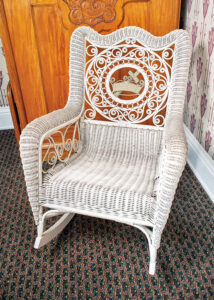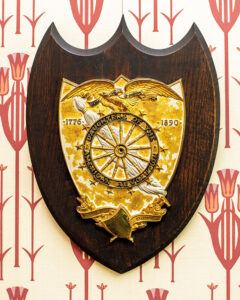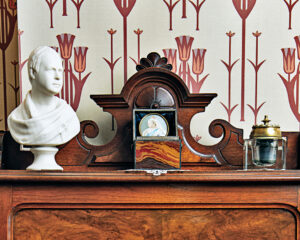In May 2024, Longyear Museum successfully completed a thorough restoration of 400 Beacon Street, the final residence of Mary Baker Eddy, the Discoverer, Founder, and Leader of Christian Science. In this online series, we reprise “‘The Dearest Spot on Earth’” from the 2024 issues of the Longyear Review, taking readers on a tour through the interior of the immaculately restored house in Chestnut Hill, Massachusetts. Rooms from Part 1 of the series were placed online between October 2024 and January 2025. Now, we are regularly adding new rooms from Part 2 of the series to the “itinerary.”
What happened in this room?
From childhood, Mary Baker Eddy “loved to sit by the window at eventide and look out upon the stars and upon the lights of the town,” secretary Irving Tomlinson recalled.1 With the move to Chestnut Hill, Mrs. Eddy requested a room mirroring a similar one at Pleasant View, with a view to the street and its passing flow of carriages and other vehicles. Duly added over the new porte-cochère in 1907, prior to her arrival, the West Room is not officially part of her suite, which includes four connected rooms—bedroom, study, dressing room, and the Pink Room—but Mrs. Eddy used it almost every evening. Here, she took time after supper for “a little social relaxation,” according to personal maid Adelaide Still. “I often found Mr. Frye chatting with her about events or news of the day.”2 Other workers, including Adam Dickey, recall her reminiscing with them about her life as they visited during these twilight hours.

A precious gift: The handsome white wicker rocking chair with the cross and crown emblem intricately woven into its back was a gift to Mrs. Eddy from grateful inmates at the New Hampshire State Prison. Prison reform was a subject close to her heart, and she encouraged Irving Tomlinson to share Christian Science there and in other correctional institutions. Like most of the furnishings in this room, the rocker was donated to Longyear by The Mother Church, The First Church of Christ, Scientist, in Boston.

Revolutionary roots: Mrs. Eddy’s framed 1893 certificate of membership in the Daughters of the American Revolution and a striking DAR coat of arms are displayed in this room and speak to her deep sense of patriotism. Mrs. Eddy’s paternal great-grandfather and both of her grandfathers served in the Revolutionary War. “I have one innate joy, and love to breathe it to the breeze as God’s courtesy,” she wrote in an April 1899 Concord Monitor, her hometown newspaper at the time. “A native of New Hampshire, a child of the Republic, a Daughter of the Revolution, I thank God that He has emblazoned on the escutcheon of this State, engraven on her granite rocks, and lifted to her giant hills the ensign of religious liberty—‘Freedom to worship God.’”3

Photo at top of page: This chaise afforded Mrs. Eddy a view of the sunset and busy Beacon Street. Calvin Frye’s photo hangs on the wall.
Each “stop” in these freshly interpreted period rooms touches on fascinating details about historic restoration. And it also offers a window into the daily routines of “family” life and the prayer and practical accomplishments that took place during the three years that Mrs. Eddy and her staff lived and worked at 400 Beacon Street (1908–1910).
“The Dearest Spot on Earth”: Part 1
Introduction
The Library (October 2024)
The Dining Room (November 2024)
Mrs. Eddy’s Study (December 2024)
The Pink Room (January 2025)
Calvin Frye’s Office (February 2025)
“The Dearest Spot on Earth”: Part 2
Introduction
The Kitchen (June 2025)
The West Room (this page)
Still to come:
Laura Sargent’s Room
The Sewing Room